City living doesn’t mean giving up fresh herbs or juicy tomatoes. Imagine turning your cramped outdoor space into a thriving green oasis. With lightweight, breathable containers like those from Spring Pot or GrowinBag, even the smallest ledges can burst with life.
These modern planters aren’t your grandma’s clay pots. Made from durable fabric or recycled plastics, they let roots breathe better, leading to healthier plants and bigger harvests. Plus, their foldable design means you can rearrange your mini garden anytime—no heavy lifting required.
Why stick to traditional methods? Brands like Green GrowMaster prove that sustainable choices don’t sacrifice style. Whether you’re growing basil for pasta night or strawberries for dessert, these space-savers adapt to your needs. They’re also kinder to the planet, using materials that last seasons.
Ready to start? This guide walks you through picking the right tools, choosing sun-loving veggies, and designing layouts that wow. By the end, you’ll know exactly how to turn every inch of your balcony into a lush, productive retreat. Let’s dig in!
Welcome to Your Urban Grow Bag Journey
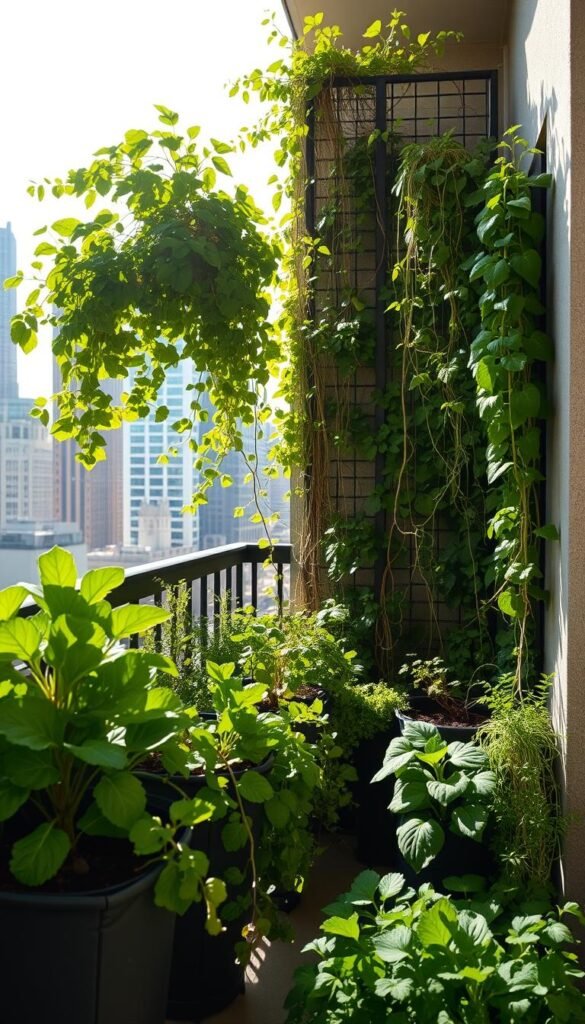
Your balcony holds untapped potential. Whether you’re nurturing herbs or cherry tomatoes, fabric containers let you create a vibrant oasis without sacrificing style. Let’s explore how these tools simplify your journey—no prior experience needed.
Discover the Benefits of Grow Bag Gardening
Why do city dwellers rave about these planters? Portability tops the list. Unlike bulky pots, lightweight designs let you chase sunlight or shield delicate plants from harsh weather. One Brooklyn gardener shared: “I moved my peppers three times a day during heatwaves—they thrived!”
Vertical gardening doubles your space. Stackable options let you grow upwards, perfect for compact areas. Pair them with rail-mounted planters, and suddenly your garden feels twice as lush.
Why Urban Gardeners Love Grow Bags
Traditional pots can’t compete. Fabric materials prevent root circling, leading to healthier yields. A Seattle workshop participant harvested 15 lbs of tomatoes from just two containers last summer!
Worried about space? Even a 3-foot-wide ledge can host basil, lettuce, and dwarf peppers. Communities like Urban Growers NYC host seed swaps to help beginners succeed. Ready to design your paradise? The next sections break it down step-by-step.
Understanding the Basics of Grow Bag Gardening
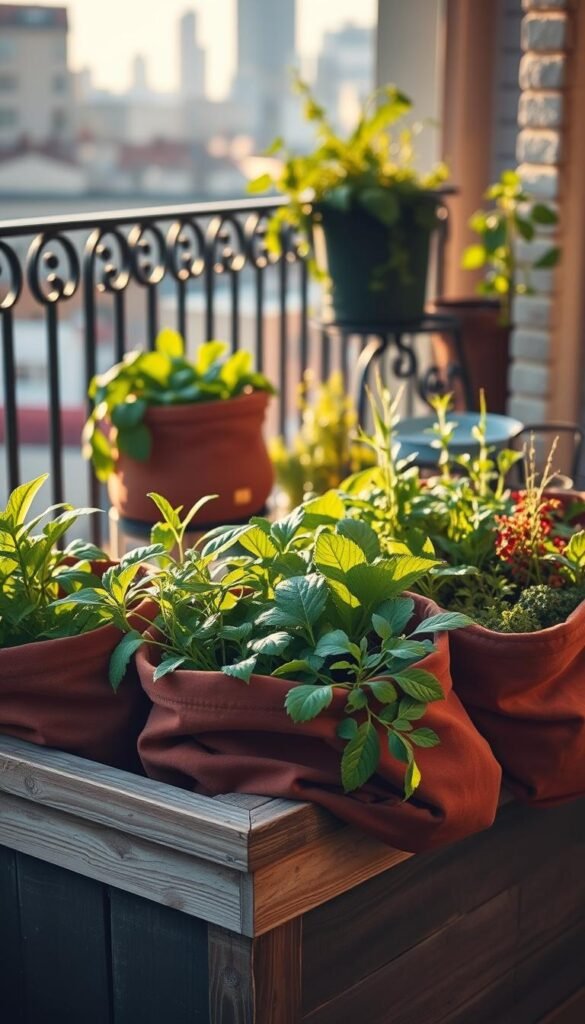
Maximizing greenery in small spots requires innovative containers. These flexible plant homes solve common challenges like poor drainage and cramped roots. Let’s unpack why they’re becoming essential for modern plant lovers.
What Are Grow Bags?
Think of them as breathable pockets for your plants. Made from porous fabrics or recycled plastics, they let roots access oxygen while preventing overcrowding. Brands like Spring Pot use geotextile materials that naturally prune roots, creating denser networks for nutrient absorption.
Unlike rigid pots, these soft-sided containers adapt as plants grow. A GrowinBag user noted: “My zucchini doubled in size once I switched—no more stunted roots!” Three main types exist:
- Fabric: Promotes air flow and prevents waterlogging
- Plastic: Lightweight and often foldable
- Biodegradable: Eco-friendly option for short-term crops
Portability, Versatility, and Space-Saving Advantages
Need to shuffle plants chasing sunlight? Lift-and-go designs make it easy. One gardener grows lettuce on a rolling cart—moving it from morning rays to afternoon shade takes seconds.
Vertical stacking multiplies your planting area. Pair tall containers with rail hooks, and suddenly you’ve got tiers of herbs without sacrificing floor space. Even a 2-foot windowsill can host cherry tomatoes when using slim rectangular models.
Traditional pots trap moisture, but these breathable alternatives keep soil fresh. Their lightweight build also means no cracked tiles from heavy ceramic planters. Ready to explore how materials impact your results? Let’s dive deeper.
Grow Bags for Urban Gardening: Boosting Yields on Tiny Balconies
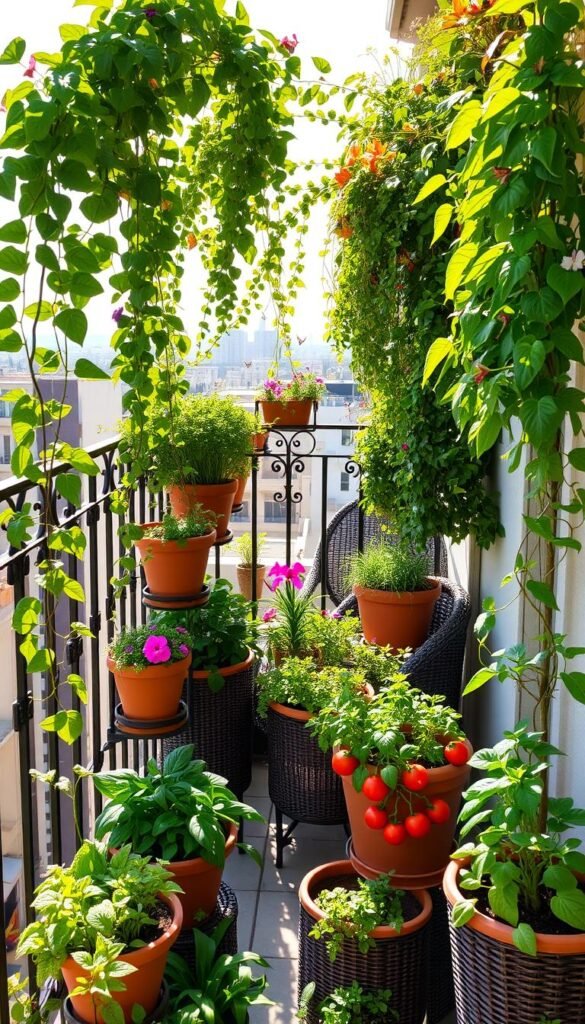
That sunlit corner you’ve been using as storage? It’s about to become your personal farmers market. Flexible containers revolutionize how we use vertical and horizontal areas, turning awkward nooks into lush edible displays.
How This Method Transforms Small Balcony Spaces
Meet Sarah from San Francisco. Her 40-square-foot fire escape now hosts 18 plants through vertical stacking. “I grow kale at eye level and strawberries near the railing,” she says. This layered approach triples usable space without clutter.
Lightweight designs let you chase sunshine effortlessly. One Chicago gardener rotates her mint every morning to catch dawn light—then shifts basil into afternoon shade. No more fried herbs during heatwaves!
Creative layouts make all the difference. Try these ideas:
- Hang rectangular planters under railings for trailing cherry tomatoes
- Use tiered stands to create a “staircase” of herbs
- Pair tall leafy greens with low-growing radishes
Even narrow ledges thrive with slim-profile containers. A Brooklyn couple harvests 10 lbs of peppers monthly from their 2-foot-wide setup. Their secret? Frequent rotation ensures each plant gets prime sunlight hours.
This approach isn’t just space-smart—it’s yield-boosting. Breathable materials prevent root rot, while easy repositioning protects against harsh weather. Ready to find your perfect containers? Let’s explore materials that make these transformations possible.
Choosing the Right Grow Bags and Materials
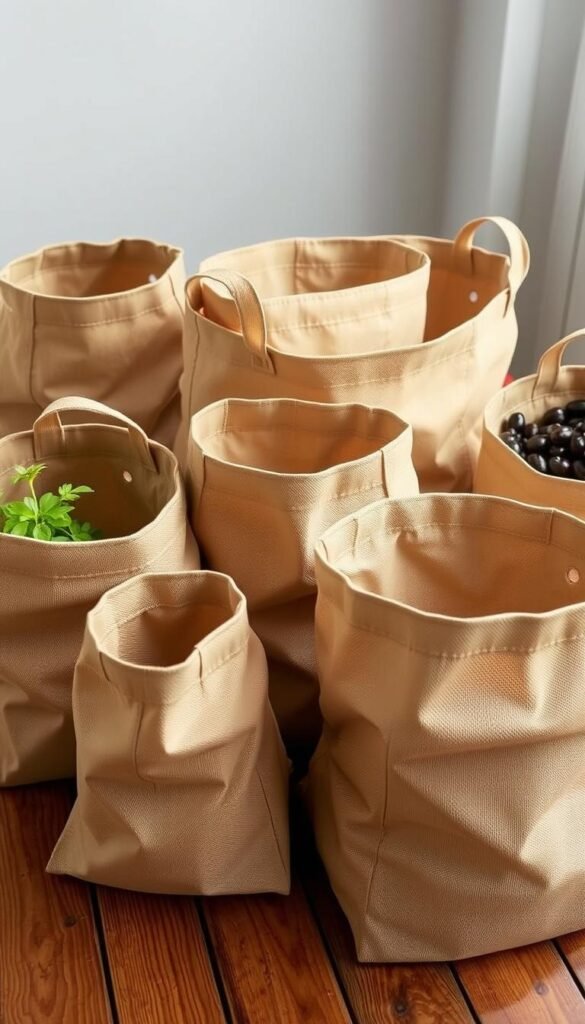
Your plant’s home matters as much as sunlight and water. Let’s break down how to pick containers that boost growth without cluttering your space.
Size and Material Considerations
Match your container’s size to your plant’s future roots. Tomatoes need 10-gallon fabric grow bags, while herbs thrive in 3-gallon pots. Spring Pot’s 7-gallon options work wonders for peppers—roots spread comfortably without drowning in extra soil.
Fabric, Plastic, or Biodegradable Options
Fabric containers like Spring Pot’s AirPrune series prevent root circling. Plastic versions are lighter—perfect for renters who move plants often. Biodegradable coconut fiber bags suit quick crops like lettuce but crumble after one season.
Here’s a quick comparison:
- Fabric: Lasts 5+ years, improves air flow
- Plastic: Foldable, less eco-friendly
- Biodegradable: Composts naturally, limited reuse
Pair any choice with quality potting mix. Cheap soil compacts, choking roots. Look for containers with drainage holes or mesh bottoms—Spring Pot’s self-watering designs keep moisture steady during heatwaves.
Durability vs. eco-impact? Heavy-duty fabrics handle years of use but cost more upfront. Start with 2-3 versatile sizes to test what fits your routine. Your leafy friends will thank you!
Setting Up Your Balcony Garden for Success
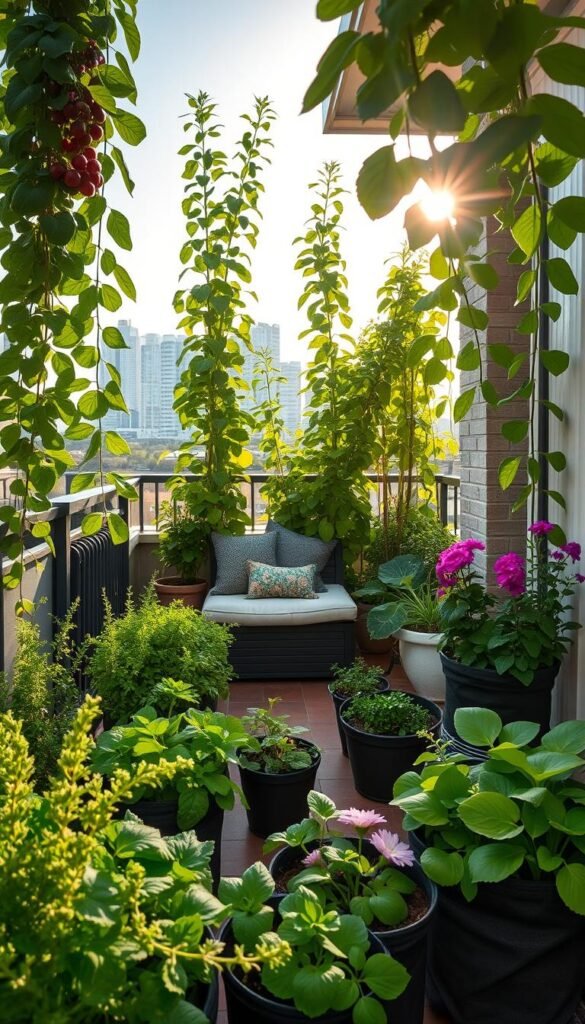
Ever wondered why some balcony gardens flourish while others struggle? The secret lies in strategic setup. Let’s transform your outdoor nook into a thriving green haven with science-backed placement and weight management tricks.
Optimal Placement and Sunlight Exposure
Track sunlight patterns for 3 days. Most edibles need 6+ hours daily. Position leafy greens in partial shade and fruiting plants like tomatoes where rays hit hardest. “Rotating containers weekly prevents lopsided growth,” notes a Boston gardener who harvests 20 lbs of veggies annually.
Use lightweight stands to elevate plants for better light absorption. South-facing spaces? Add shade cloth during midday heat. North-facing? Reflective surfaces like white walls can boost brightness by 30%.
Ensuring Proper Drainage and Weight Distribution
Overwatering drowns roots faster in containers than ground soil. Mix perlite into potting soil and elevate bags with pot feet. A Chicago urban farmer shares: “Adding gravel trays under my herbs stopped water stains on the balcony floor.”
Check your building’s weight limits—filled 10-gallon containers weigh ~80 lbs. Distribute heavier plants near support walls. For windy spots, secure vertical stacks with bungee cords anchored to railings.
Self-watering pots from brands like Gardener’s Supply maintain moisture without daily attention. Pair them with drip lines for vacations. Remember: healthy roots need air as much as water and sunlight.
Tips for Optimal Plant Growth in Tight Spaces
Nailing plant care in compact areas requires clever strategies. Let’s explore how to keep your greenery thriving without drowning in maintenance tasks.
Water Wisdom for Busy Plant Parents
Overwatering kills more balcony plants than neglect. Stick your finger 1″ into the soil—if it’s damp, wait. Self-watering pots from Gardener’s Supply maintain perfect moisture for up to 5 days. Pair them with drip lines for vacations.
Try this weekly routine:
- Morning watering to reduce evaporation
- Mulch with cocoa hulls to lock in moisture
- Group plants by water needs (thirsty tomatoes vs. drought-tolerant rosemary)
| Method | Efficiency | Space Impact |
|---|---|---|
| Drip irrigation | 90% water retention | Fits under railings |
| Self-watering pots | Low maintenance | Ideal for narrow ledges |
| Watering cans | Precise control | Requires storage space |
Breathe Easy: Airflow Matters
Stagnant air invites mildew. Rotate pots weekly and space them 4-6″ apart. A Brooklyn gardener shares: “Using mini fans cut my basil’s leaf spot issues by half!” Vertical stacking? Leave gaps between tiers for proper circulation.
Key health checks:
- Prune yellow leaves weekly
- Use cinnamon powder as natural antifungal
- Stake tomatoes early to prevent crowding
Companion planting saves space and deters pests. Try basil with peppers—they’ll share nutrients while repelling aphids. Remember: healthy roots need oxygen as much as water and sunlight!
Smart Plant Selection for Maximum Yields
What if your balcony could produce more food than you expect? Choosing the right vegetables and herbs turns limited space into a powerhouse of fresh flavors. Let’s explore which varieties thrive in containers and how to pair them for year-round harvests.
Space-Smart Crops for Every Season
Leafy greens like spinach and kale grow fast in shallow containers. Dwarf tomato varieties like ‘Tiny Tim’ yield pint-sized fruits perfect for salads. Herbs such as basil and cilantro flourish in 6-inch pots—snip leaves weekly for continuous growth.
Flowers aren’t just pretty. Marigolds repel pests while attracting pollinators. Try these compact stars:
- Spring: Pea shoots, radishes, nasturtiums
- Summer: Cherry tomatoes, bush beans, lavender
- Fall: Swiss chard, parsley, pansies
Buddy System Gardening
Companion planting boosts yields naturally. Grow basil beneath tomatoes—it repels hornworms while enhancing flavor. A Boston gardener reports: “My pepper plants doubled their output when paired with marigolds!”
Rotate crops every 8-12 weeks. After harvesting lettuce, plant fast-growing arugula. Use vertical space for climbing beans once spring peas finish. This strategy keeps your garden productive through all four seasons.
Remember: Match varieties to your sunlight. North-facing spaces? Stick to mint and parsley. South-facing? Eggplants and rosemary will bask in the rays. Your balcony’s microclimate determines what thrives!
Incorporating Vertical Gardening and Creative Layouts
When floor space disappears, look up—your vertical real estate holds endless possibilities. Creative arrangements turn blank walls and railings into lush green tapestries. A Chicago resident transformed her 50-square-foot balcony into a cascading herb haven using rail-mounted planters. “I harvest mint for tea while standing at eye level,” she shares.
Utilizing Hanging Baskets and Rail-Mounted Planters
Hanging baskets reclaim overhead space for strawberries or trailing nasturtiums. Opt for self-watering models to reduce daily upkeep. One New Yorker grows cherry tomatoes in rail-mounted pockets: “They get full sun without hogging my tiny table!”
Secure planters with heavy-duty brackets in windy areas. Layer them at different heights to create visual depth. Try these combos:
- Basil in upper tiers for easy snipping
- Lettuce in shaded lower pockets
- Pansies adding pops of color between edibles
Making the Most of Your Vertical Space
Trellises double as functional art. Train peas or beans upward using bamboo grids—they’ll shade heat-sensitive greens below. Pocket planters made from recycled fabric let you grow 15+ plants on a 3-foot wall.
Vertical setups improve airflow, reducing mildew risks. A Los Angeles gardener credits her thriving kale to vertical garden spacing: “Leaves dry faster after watering, so no more rot.” Pair these systems with ground-level containers for a multi-layered harvest.
Start small—add one hanging planter this week. Soon, you’ll see walls not as limits, but as blank canvases for your green thumb.
Essential Tools and Supplies for Urban Grow Bag Success
Equipping your space with smart solutions turns cramped areas into thriving ecosystems. The right gear simplifies maintenance while boosting plant health—no green thumb required.
Self-Watering Containers, Drip Irrigation, and Mulching
Consistent moisture is non-negotiable. Self-watering planters like Gardener’s Supply’s Tomato Success Kit store extra water in reservoirs. A Portland user shares: “My basil stayed lush during a 10-day vacation!”
Drip irrigation systems shine for multi-container setups. The Rain Bird Micro Bubbler Kit waters 12 planters simultaneously. Pair it with a timer for hands-off care. See how methods compare:
| Method | Best Use Case | Maintenance Needs |
|---|---|---|
| Self-watering | Single containers | Refill weekly |
| Drip lines | Rail-mounted systems | Seasonal flush |
| Manual watering | Small collections | Daily checks |
Premium soil mix makes all the difference. Avoid bargain blends—they compact over time. Look for these ingredients:
- Coconut coir for drainage
- Worm castings for nutrients
- Perlite to prevent clumping
Choose containers with reinforced handles and UV protection. Brands like Smart Pots offer 5-year warranties—ideal for harsh climates. Clean fabric planters with vinegar after each season to prevent mold.
Mulch with straw or shredded bark to lock in moisture. A Chicago gardener reduced watering by 40% using this trick. Remember: Quality tools pay off through bigger harvests and fewer headaches!
Community Insights and Sustainable Gardening Practices
Connecting with fellow plant lovers multiplies your success. Local groups offer fresh ideas for maximizing limited areas while building eco-conscious habits. From shared resources to expert guidance, collaboration turns challenges into triumphs.
Workshops, Seed Swaps, and Local Urban Gardening Groups
Seattle’s Urban Garden Collective hosts monthly skill-sharing events. Members trade heirloom seeds and troubleshoot pest issues together. “I learned to grow shishito peppers in 5-gallon containers from a neighbor,” shares member Clara Rodriguez. These gatherings demystify sustainable practices through hands-on demos.
Detroit’s Greening Initiative pairs beginners with mentors. Their seed libraries let you “borrow” packets for seasonal crops. Return seeds from your harvest to keep the cycle going!
- Attend free composting workshops at community centers
- Join Facebook groups like Urban Harvest Exchange for tool swaps
- Visit farmers’ markets to connect with local experts
Eco-Friendly Tips for Long-Term Success
Turn kitchen scraps into gold. Bokashi bins transform food waste into nutrient-rich soil in weeks—perfect for small spaces. Pair this with rainwater collection systems to reduce your environmental footprint.
Try these planet-friendly sustainable balcony garden tips:
- Use biodegradable pots for quick-growing herbs
- Install solar-powered LED lights for evening care
- Choose native pollinator plants to support local ecosystems
Portland’s Green Space Alliance reports 63% higher yields in gardens using these methods. Remember: every eco-choice, from mulching with newspaper to repurposing containers, strengthens your green space’s future.
Wrapping Up Your Urban Gardening Journey
Your concrete jungle retreat just got greener. Through smart containers and clever layouts, you’ve discovered how to transform cramped spaces into lush havens. Remember: choosing breathable pots prevents root rot, while vertical designs triple your planting real estate.
Start small—try one fabric planter with basil or cherry tomatoes. Track sunlight patterns and rotate plants weekly for even growth. Local nurseries often host free workshops to help beginners master these tips.
Join communities like Urban Harvest Exchange to swap seeds and celebrate wins. One Denver gardener grew 14 lbs of veggies last summer using rail-mounted systems—proof that limited space can’t limit creativity.
Ready to taste your first homegrown pepper? Grab a 5-gallon container, pick a sunny corner, and plant today. Every harvest teaches something new. Your balcony garden isn’t just a project—it’s a way to reconnect with nature’s rhythms, one leaf at a time.






